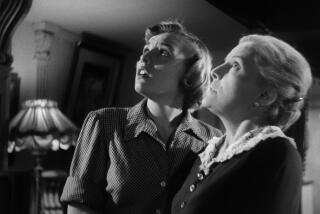A ‘Greed’ More as Stroheim Had Intended
“Greed,” Erich von Stroheim’s 1924 mutilated masterpiece, stands as Hollywood’s archetypal example of art destroyed by commerce. Stroheim had the audacity to bring Frank Norris’ Zolaesque 1899 novel “McTeague” to the screen for the Goldwyn Co. as a 9 1/2-hour epic. In a singular stroke of bad luck for Stroheim, during the film’s production Goldwyn merged with Metro to become Metro-Goldwyn-Mayer. It was to bring the director into a confrontation with the new studio’s chief, Louis B. Mayer, and his production head, Irving Thalberg (with whom Stroheim had battled at Universal since the beginning of his directing career).
Stroheim was a fabled damn-the-expense perfectionist with a fascination with the perverse and decadent that would give any producer or studio pause. But the point here is that Thalberg, understandably eager to reduce “Greed’s” mammoth running time, saw no merit in attempting to preserve for posterity the vast amount of footage he ordered deleted. “Greed” was eventually taken away from Stroheim and handed over to editor Joe Farnham, who created the roughly 140-minute version that endures to this day.
Producer-filmmaker Rick Schmidlin, acclaimed for his restoration of Orson Welles’ “Touch of Evil,” discovered the Academy of Motion Picture Arts and Sciences’ Margaret Herrick Library held some 650 stills from “Greed” plus a continuity screenplay longer by 50 pages than the version he had already read. At that point, Schmidlin felt a reconstruction of “Greed” was actually viable.
Incorporating 633 of these stills and digital animation techniques pioneered by Ken Burns for his epic documentary “The Civil War,” Schmidlin and his team created a 4 1/2-hour, two-part “Greed,” which will have its world premiere Sunday on Turner Classic Movies at 5 p.m. The authentically tinted, razor-sharp print will be accompanied by Robert Israel’s majestic, somber new score.
The story of a humble, ill-fated San Francisco dentist, John (Mac) McTeague (Gibson Gowland), “Greed” not surprisingly has a much richer context than ever before. Schmidlin has created highly effective montages of those stills, intercut with appropriate intertitles. That Schmidlin has been able to pan those stills and make use of iris dissolves, a popular transitional device in films at that time, helps integrate them smoothly into the flow of Stroheim’s always eloquent footage. This amplified “Greed,” nevertheless, suggests that Stroheim might well have done away with--or at least played down--a lurid and inescapably redundant subplot dealing with a greedy junk dealer (Cesare Gravina) and a balmy boardinghouse charwoman (Dale Fuller).
The reconstructed introductory sequences, however, are invaluable to our understanding of McTeague, a beefy giant, gentle yet capable of terrible rages, a simple man whose mass of blond curls gives him an enduring boyishness. When we meet McTeague, in 1908, he is a young Placer County gold miner with an acutely alcoholic father and a worn-down mother who seizes an opportunity for her son’s escape into a better life as an apprentice to a dubious, itinerant dentist.
McTeague nevertheless learns well and settles into an office-apartment in a boardinghouse over a row of stores on San Francisco’s Polk Street. Through his best friend Marcus (Jean Hersholt) he meets Trina (Zasu Pitts), the demure daughter of folksy German immigrants, and is immediately captivated. Although smitten with Trina himself, Marcus stands aside only to be gradually but remorselessly consumed by envy when Trina wins a $5,000 lottery on the eve of her wedding to McTeague. All three stars give truly towering portrayals.
While “Greed” punches out its money-is-the-root-of-all-evil theme, Stroheim is actually showing us with sophisticated psychological insight that the lottery windfall is laying bare inherent weaknesses in McTeague and Trina that might otherwise have lain dormant, an approach that allows us to ponder our own vulnerabilities. Beyond this, “Greed,” filmed entirely on location with the exception of some fantasy sequences, is a stunningly timeless and ultra-realistic portrait of the frequently brutal and treacherous existence of America’s working class, a large portion of it made up of immigrants, then as now.
Even in its truncated form “Greed” has always been widely praised and listed among the all-time great films. Now Rick Schmidlin has made “Greed” greater than ever.
* “Greed” can be seen Sunday at 5 p.m. on TCM.
More to Read
Only good movies
Get the Indie Focus newsletter, Mark Olsen's weekly guide to the world of cinema.
You may occasionally receive promotional content from the Los Angeles Times.










